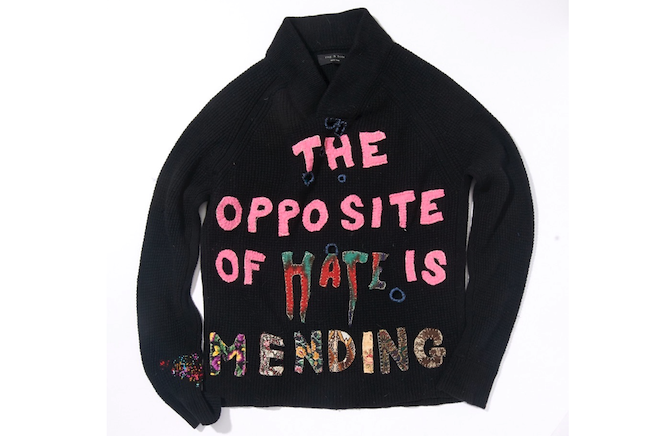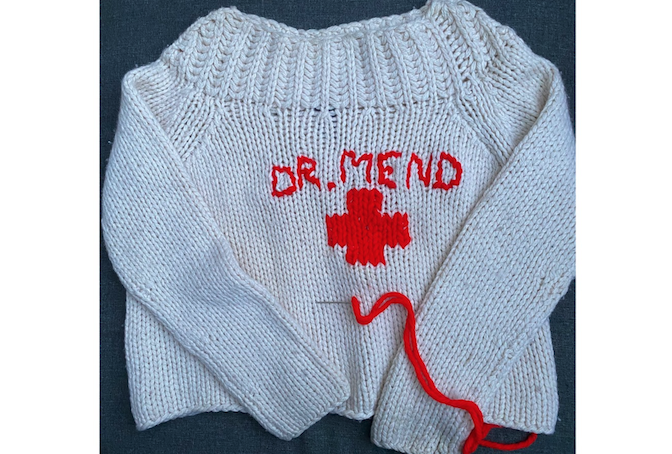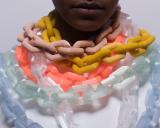Fashion + Design > Fashion
March 24, 2021
Kate Sekules – Any mend is better than no mend
Susanne Barta
Ich habe Kate über meine Schwester Ulli kennengelernt. Sie hat mich hingewiesen auf Kates Instagram und ihre beeindruckenden „Mending-Skills“. Mending kann man auf deutsch etwas holprig übersetzen mit Ausbessern. Darum geht’s auch, aber es geht vor allem darum, Textilien länger im Kreislauf zu halten, sie zu reparieren, zu flicken, zu nähen, zu besticken, zu stopfen, mit Patches zu versehen … Und es geht auch um Stil, vor allem um individuellen Stil. Kate ist radikale Fast Fashion Gegnerin, Vintage- und Secondhand-Fan und macht vor, wie man Mode über alles lieben kann, sich aber nicht dem Markt- und Konsum-Diktat unterwerfen muss. Sondern seinen eigenen und für Mensch und Umwelt besseren Weg gehen kann, ohne auf Style zu verzichten.
Das Wichtigste: die „Ausbesserungen“ sollen sichtbar sein. Hier wird nicht still und heimlich geflickt und gestickt, sondern richtig auffällig. Mending sei modisches und politisches Statement gleichzeitig, sagt Kate Sekules. Die Britin lebt seit vielen Jahren in NYC und ist eine der internationalen Mending-Expertinnen. Sie unterrichtet und gibt Workshops – u. a. an der New York University, Parsons, the Fashion Institute of Technology, the Textile Art Center, the Costume Society of America und the UK Association of Dress Historians –, ihre Texte erschienen in der Vogue, Harper’s Bazaar, The New Yorker, Guardian und The New York Times. Vor kurzem kam bei Penguin Kates Buch „Mend! A Refashioning Manual and Manifesto“ heraus. Ich bin ja kein sehr geschickter Mensch, aber ich lese Kates Buch nicht nur mit großem Vergnügen, sondern habe auch schon begonnen Stiche zu üben, habe einige Wollknäuel und Garn gekauft und bereits ein erstes Mottenloch sichtbar bearbeitet. Schritt für Schritt leitet Kate durch die verschiedenen Stich-Varianten und Techniken, zeigt, was alles möglich ist und wie. Und nimmt auch jemandem wir mir die klassische Ausrede „ich kann das nicht“. Dazu gibt’s viel über die Geschichte des Mending zu erfahren, das ja so alt ist wie Textilien selbst, Kate stellt ihre Mending-Ikonen vor, erzählt, warum sich die Modeindustrie ändern muss und gibt Tipps, wie man das auch konkret umsetzen kann. Und sie macht Schluss mit einigen Mrs.-Kondo-Wahrheiten, zum Beispiel, dass alles, was man ein Jahr nicht getragen hat, entsorgt werden soll. So ein Quatsch. Auch ich habe Teile in meinem Schrank, die ich jahrelang nicht trage und dann mit großer Freude wieder hervorhole. Eine meiner Lieblingsseiten im Buch ist das „Instant Expert Vintage Cheat Sheet“, wo die wichtigsten Charakteristiken der verschiedenen Stil-Epochen aufgelistet sind. Ich freue mich sehr, euch Kate hier vorzustellen:
Ich bin ja kein sehr geschickter Mensch, aber ich lese Kates Buch nicht nur mit großem Vergnügen, sondern habe auch schon begonnen Stiche zu üben, habe einige Wollknäuel und Garn gekauft und bereits ein erstes Mottenloch sichtbar bearbeitet. Schritt für Schritt leitet Kate durch die verschiedenen Stich-Varianten und Techniken, zeigt, was alles möglich ist und wie. Und nimmt auch jemandem wir mir die klassische Ausrede „ich kann das nicht“. Dazu gibt’s viel über die Geschichte des Mending zu erfahren, das ja so alt ist wie Textilien selbst, Kate stellt ihre Mending-Ikonen vor, erzählt, warum sich die Modeindustrie ändern muss und gibt Tipps, wie man das auch konkret umsetzen kann. Und sie macht Schluss mit einigen Mrs.-Kondo-Wahrheiten, zum Beispiel, dass alles, was man ein Jahr nicht getragen hat, entsorgt werden soll. So ein Quatsch. Auch ich habe Teile in meinem Schrank, die ich jahrelang nicht trage und dann mit großer Freude wieder hervorhole. Eine meiner Lieblingsseiten im Buch ist das „Instant Expert Vintage Cheat Sheet“, wo die wichtigsten Charakteristiken der verschiedenen Stil-Epochen aufgelistet sind. Ich freue mich sehr, euch Kate hier vorzustellen:
Kate, how come you became a mending expert?
I have mended all my life and was one of the first to be doing visible mending and yet I’m a little uncomfortable with the word ‘expert’ . I see what I do as spreading the word and helping and enthusing rather than being some great and noble teacher. Mending is a humble skill for everyone and anyone, and there are a whole lot of people claiming to be experts lately, not all of them deserving the title!
But I have to say, I am thrilled with your mending skills; does it take a lot of practice to learn this really well?
Thank you! Like anything, practice definitely helps with mending, but I think it’s more important to just start than to aim for perfection. I thought my first visible mends were marvelous but looking back they were pretty terrible – but so what? I am still mending on top of those terrible mends and they get better and better. Layered mends are often best. So what I’m saying is, you will improve fast, and you will be very pleased with yourself. Why should we mend?
Why should we mend?
It’s simple. We produce and buy and discard too much. The planet can’t handle it and people are exploited in their millions. And COVID has only made that worse. But that’s the negative reasoning. On the positive side – mending is just really fun and creative and fulfilling. The visible kind is a fashion statement that personalizes your wardrobe, creates something fabulous every time, and costs very little.
The fashion industry wants us to consume more and more, can mending, darning and patching be a contemporary and cool counter strategy?
Absolutely. The industry has been dying for a long time now, and the mega companies should die. They exploit. So don’t buy into the scheme. Visible mending tends to have a certain look, but there are as many ways to mend as there are ways to design – contemporary mending is really cool and can stay around forever, with infinite looks. Fashion is not all bad, far from it: it’s important to support the special, independent, creative designers, and many are including reuse strategies, circular design and mending in their work now.
Your book is part how-to, part manifesto; what do you want people to take with them when they’ve read your book?
Aside from – start mending! – I want people to be VERY excited to go into their own wardrobe immediately and start playing. To realize they already have all they need to focus their style, become an ethical dresser, and look amazing and unique. To deepen their relationship with clothes. What is the best way to get started with mending?
What is the best way to get started with mending?
Just start! It can be intimidating, but there is no other way to get through the fear. It is hard to stab or cut your clothes at first, but once you’re over the hump, you won’t look back. As far as techniques (I’ve broken them down into 34 separate ones, with charts and everything in the book), the ones I call Patchiko and Porthole are the easiest and they look incredibly cool, so start with those.
How would you describe your style?
Eclectic, playful, avant garde, multi-era, trending 1970s. I wear only vintage (and things that went vintage in my closet) and love and collect certain designers – CDG, Junya, Margiela, Dries, Zero Maria Cornejo, Bill Gibbs, and original Biba. I usually build around a piece that’s speaking to me today, and love mixing pattern and color. I wore all black for years, now I almost avoid it.
What else?
Getting dressed should be fun and inspiring, but the Fashion Industrial Complex is a boot in the face. Break free and mend! Kate wird auf dem GREENSTYLE (Responsible) Fashion Summit eine kurze Keynote und am 10. April 2021 am Nachmittag einen Workshop halten. Ihr könnt Kleidungsstücke, die ein Makeover benötigen, mitbringen und Kate gibt Tipps wie man sie am besten flickt. Natürlich nicht einfach so flickt, sondern richtig cool flickt. Ihren Workshop „More is more – The Mending Surgery” beschreibt sie so: Make an appointment at Dr. Mend’s surgery for your sick or injured garment. Get a personal consultation and a prescription for your rip, hole, stain, or damage. See other cases and treatments and medication in progress live! We will end with a live tutorial on Dr Kate’s signature Patchiko mend. Materials: a hole, a patch large enough to generously cover it, needle and thread: embroidery floss is ideal.
Kate wird auf dem GREENSTYLE (Responsible) Fashion Summit eine kurze Keynote und am 10. April 2021 am Nachmittag einen Workshop halten. Ihr könnt Kleidungsstücke, die ein Makeover benötigen, mitbringen und Kate gibt Tipps wie man sie am besten flickt. Natürlich nicht einfach so flickt, sondern richtig cool flickt. Ihren Workshop „More is more – The Mending Surgery” beschreibt sie so: Make an appointment at Dr. Mend’s surgery for your sick or injured garment. Get a personal consultation and a prescription for your rip, hole, stain, or damage. See other cases and treatments and medication in progress live! We will end with a live tutorial on Dr Kate’s signature Patchiko mend. Materials: a hole, a patch large enough to generously cover it, needle and thread: embroidery floss is ideal. Ich habe herumgeschaut, was sich lokal so in dem Sektor tut. Von oew und vom Dachverband für Natur- und Umweltschutz gibt es Repair Cafés in verschiedenen Städten Südtirols, da kann man auch seine kaputten Kleidungsstücke wieder flott kriegen. Interessant ist die Werkstatt für angewandtes Recycling renarro in Meran, hier wird aus nicht mehr genutzten Dingen, auch Textilien, kreativ Neues entwickelt. Wenn ihr jemanden kennt, der „visible“ und cool ausbessert, flickt, patcht und stickt, gebt mir bitte Bescheid.
Ich habe herumgeschaut, was sich lokal so in dem Sektor tut. Von oew und vom Dachverband für Natur- und Umweltschutz gibt es Repair Cafés in verschiedenen Städten Südtirols, da kann man auch seine kaputten Kleidungsstücke wieder flott kriegen. Interessant ist die Werkstatt für angewandtes Recycling renarro in Meran, hier wird aus nicht mehr genutzten Dingen, auch Textilien, kreativ Neues entwickelt. Wenn ihr jemanden kennt, der „visible“ und cool ausbessert, flickt, patcht und stickt, gebt mir bitte Bescheid.
Fotos: (1–4) © Kate Sekules; (5) © Liisa Jokinen; (6) © Susanne Barta; (7) © Kate Sekules


















Comments